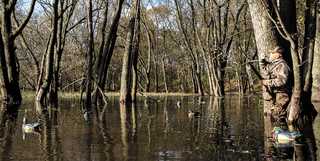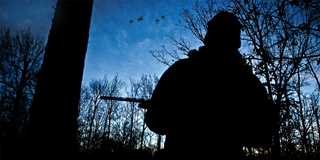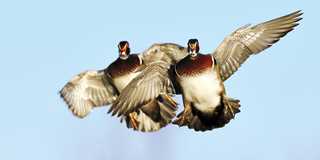The Wonderful Wood Duck
On a quest for a thousand wood duck sunrises, the author explains his obsession with Aix sponsa
On a quest for a thousand wood duck sunrises, the author explains his obsession with Aix sponsa

by T. Edward Nickens
We are right where the ducks had been, where they were when I scouted the creek just yesterday morning and the morning before that, when I stood back in the dark woods and watched them pour out of the early light. They were here, but these are wood ducks, and all bets are off. I shift my weight in my waders and begin to second-guess myself. Will they be back? Werent they here by this time yesterday? The shotgun rides on the point of my hip, at the ready. My son, Jack, is 15 feet downstream, and I sense him squirming with doubt.
Mosquitoes whine in my ears.
Of course, theyll be back. Why wouldnt they be back?
Where are the birds?

Photo JEFFMOOREIMAGES.NET
But it is like this with these ducks. It is never a gimme with the woodie. They are everywhere and nowhere, seemingly all at once.
So I breathe a sigh of relief when I hear the first wood duck coming through the trees, that sharp, telltale two-note whistle tracing the birds flight low down the creek.
Get ready, Jack! I call out. Thirty seconds to shooting light!
And then they come, and when wood ducks finally decide to show, its a show like no other.
In 30 seconds, the world turns from no ducks to ducks everywhere and all at once. Over the treetops, low on the deck of the creek, maple-leafing overhead, cutting 180s to curl into the slick water by the bank. When they come, they can come so fast and in such numbers that once the shooting starts you wish they would just slow down, for Petes sake, and give you a chance to catch your breath and reload; give you a moment to look around and take it all inthe sunrise now a watercolor wash in the east, the trees reaching up like the fingers of ancients, the ducks cartwheeling wildly at 20 feet, more behind them, more above them, whistling and squealing and trilling all around.
Could you please stop flying for just 15 seconds, so I can enjoy the show?
And when do you ever say that to a duck?
Especially this duck. One of the most acrobatic birds on the planet. One of the most common ducks in North America. And the most beautiful of any waterfowl out there.
Yes, I said it: The most beautiful. With apologies to the graceful pintail, the resplendent blue-winged teal, even the glorious northern shoveler (yes, glorious!), there is no duck more gorgeous than the wood duck drake. Henry David Thoreau considered them an ornament to a river. Their Latin name, Aix sponsa, means waterbird in a bridal dress, although a waterbird in a slinky, sequined salsa dress might be closer to the mark. Standing in a swamp, with the birds raining through the trees, whistling and peenting, silhouetted in the sunrise, its easy to understand what John James Audubon meant when he described these birds descending through the sycamores and maples of yore. Scenes like these, he wrote, I have enjoyed a thousand times, yet regret that I have not enjoyed them oftener.
He almost lived long enough to wonder if hed ever enjoy such a scene again. It wasnt too long after Audubons passing that conservationists were becoming concerned about the future of the wood duck. By the early 20th century, wood duck numbers had plummeted, due to market hunting, timber harvest, and even the trade for bird feathers that were used to decorate ladies hats. The Migratory Bird Treaty Act of 1918 closed hunting seasons for wood ducks altogether, and the hiatus lasted nearly 25 years. In 1937, biologists in Illinois developed a bark-covered wooden nesting box for wood ducks, and over the next two years more than 1,000 were erected throughout the state. Wood ducks, whose slim bodies allow them to access and nest in the small cavities drilled out by pileated woodpeckers, took to the boxes immediately. Numbers crept up, and a limited hunting season for woodies opened in 1941. The birds have been a favorite of hunters ever since, and today woodies make up about 10 percent of the total duck harvest each year in the United States.

Photo DaysAfieldPhotography.com
Personally, Im working hard on besting Audubons 1,000 wood duck sunrises. My own obsession with these ducks is not just a hunting season event, but a year-round malady. Whether Im in the woods scouting for turkeys, running the dog, or even fishing a farm pond, let me catch the faintest notes of the woodies who-eet who-eet whistle and you can clock me out and count me gone. Ill leave a tree stand or a bluegill bed to vanish into the woods, and return wet to the waist, with bloody forearms from catbrier and vine and smelling like beaver musk, with a smile as wide as my hat brim. If theres wood duck water to be found, I will find it.
This love affair with a gaudy, tree-perching, nut-eating duck began when I was in college. Between myself and my duck hunting pal, Lee Davis, we didnt have a duck boat, a duck dog, a duck canoe, or a duck club, but we had the two things college kids have in spades: Time to burn and energy to fuel the blaze. We hunted public land, and we learned early on that getting away from boat hunters required humping it far up tributary creeks and deep into swamps. The wood duck is the avian soulmate of the beaver, and anyone willing to clamber over beaver-gnawed trees and tightrope-walk a narrow beaver dam in the dark could weed out most competition. We found equal measures of solitude and wood duck holes and learned that there is a positive relationship between blood loss from briars and numbers of woodies in the bag.
Not that being a successful wood duck hunter requires butterfly sutures and antibiotic cream. What it does require is respecting the bird and fine-tuning your techniques so that your shotgun muzzle ends up pointed in the right direction when you pull the trigger. In fact, this little duck is full of lessons that can be used to sharpen skills for all kinds of waterfowl hunting. The hard trick with wood ducks is to not underestimate the bird. Dont dis the woodie, Ive said a million times to my hunting companions who dont take wood duck hunting seriously. Dont sell him short, and dont take shortcuts when a limit of wood ducks is on your wish list.
On that creek in the middle of the wood duck storm, Jack and I learned anew the critical aspect of getting to the swamp, getting set up, and being ready well before shooting light. Wood ducks tend to fly early, and you cant be futzing around with your headlamp or gloves at the magic moment. I switch my phone to vibrate mode and set two alarms: One for two minutes before shooting light, so Ill know its time to button up and be ready, and the other for exact shooting light, so Ill know the moment I have a green light to shoot.
Hunting wood ducks also sharpens my ability to analyze hunting locations not only for where I think the ducks will land but also for where Ill need to be to maximize success. These are lessons you never stop learning. Just last season I hiked into a beaver pond dammed up in the shallow tributary of a farm pond. Id scouted the swamp in the bright light of midday, and I didnt realize how much the micro-topography of the spot would affect the hunt. The swamp was settled at the bottom of a shallow bowl, rimmed by timbered ridges in three directions. I didnt take into account the darkened skylines that surrounded me. As woodies bombed in a few minutes before shooting light, I immediately realized my error. Once legal light arrived, I struggled to get decent shots. Squealers swarmed the sky, and a few wood ducks landed as close as five feet away. But I could barely make them out against the dark trees.

Photo TODDSTEELEPHOTOART.COM
I rectified my mistake the next week, positioning myself farther up the creek so my view was largely out over the pond itself, well-lit and with a low horizon created by the trees on the far shore. I gave up the opportunity to gun the birds streaking down the creek channel, but I more than made up for the loss with much better shooting opportunities at wood ducks sailing into the beaver pond over the open water and against a clear sky. Three shots, three ducks, a bag limit, and it was time to wait on the mallards.
The fast and furious action that can sometimes take place in the first few minutes of a wood duck hunt brings its own set of challenges. While you can shoot a woodie in an open impoundment or a wide river slough, they tend to gang up in thick cover, where losing a cripple or even a dead bird can be a real issue. Long ago, Lee and I hunted a massive beaver swamp that was a uniform belly-button deep for 20 acres. Low, stunted trees grew like dog hair, and wood ducks by the hundreds worked the swamp all season long. The ducks came in from every direction, and downed birds could easily vanish in the thick timber.
A good dog would have made life easier, but we didnt even have a bad dog. So we learned the discipline to call a halt to the gunning even when more birds were in flight, and retrieve every downed bird. That lesson has carried over to all my waterfowling: Shoot the bird out of the sky, shoot it again on the fall if necessary, and be ready for a coup de grace when it hits the water and raises a single feather. For me, losing a duck will ruin a hunt faster than going in over my waders.
For many hunters in the South and mid-Atlantic, the year-round ubiquity of wood ducks tends to breed a touch of disrespect. Just a couple of woodies, theyll say when asked about a slow mornings hunt. As if a couple of wood ducks were a consolation prize for a 4 a.m. wake-up call. But Im smitten by this duck. Its antics on the wing tie my shotgun barrel into knots. It lives in quiet, tucked-away, overlooked places. It takes more elbow grease and sweat to hunt wood ducks than gear and complicated tactics.

Photo BILLMARCHEL.COM
But I understand the knocks some duck hunters give the gaudy woodie. Its true that a wood duck isnt going to circle your decoys four times before committing to the spread. Theyre not as fast as teal, not as canny as black ducks. Theyre numerous and can be fairly common.
But then the first light of predawn seeps up from the east, and you have but two inches of freeboard before you overtop your waders, and your hair is matted with sweat from the long walk in, and you look around and theres not another light in the swamp. You know that this woodie hole is all yours this morning, so you crane your neck and still your breath so you can listen for what youve come for: That first whistle of a wood duck on its way, and all the wonder that will soon follow.
Wood ducks can be prepared any number of ways, but the following recipe is perhaps my favorite. Its quick, easy to prepare, and delicious.
Ingredients:
Wood duck breast fillets, skin on
Salt
Pepper
Prosciutto
Dipping sauce
Directions
[Step 1] To butterfly the skin-on duck fillets, place each fillet on a cutting board, skin-side down. Press down on the top with the palm of one hand and slice the fillet in half lengthwise, starting from the thin end of the fillet and working parallel to the cutting surface. Dont cut all the way throughleave an inch-wide strip at the thick end of the fillet. Then open up the fillet like the pages of a book.
[Step 2] Season the butterflied fillets with salt and pepper. Place prosciutto on top.
[Step 3] Roll up each fillet, starting with the skinless end, so the completed pinwheel has exposed skin to crisp on the grill. Secure with a skewer or a few toothpicks.
[Step 4] Grill for no more than 5 minutes per side, so the skin is crispy but the meat remains close to rare.
[Step 5] Serve with your favorite dipping sauces, either homemade or commercially available: maple-sriracha, bourbon-honey, and Chinese plum sauce are among
my favorites.
Ducks Unlimited uses cookies to enhance your browsing experience, optimize site functionality, analyze traffic, and deliver personalized advertising through third parties. By continuing to use this site, you agree to our use of cookies. View Privacy Policy